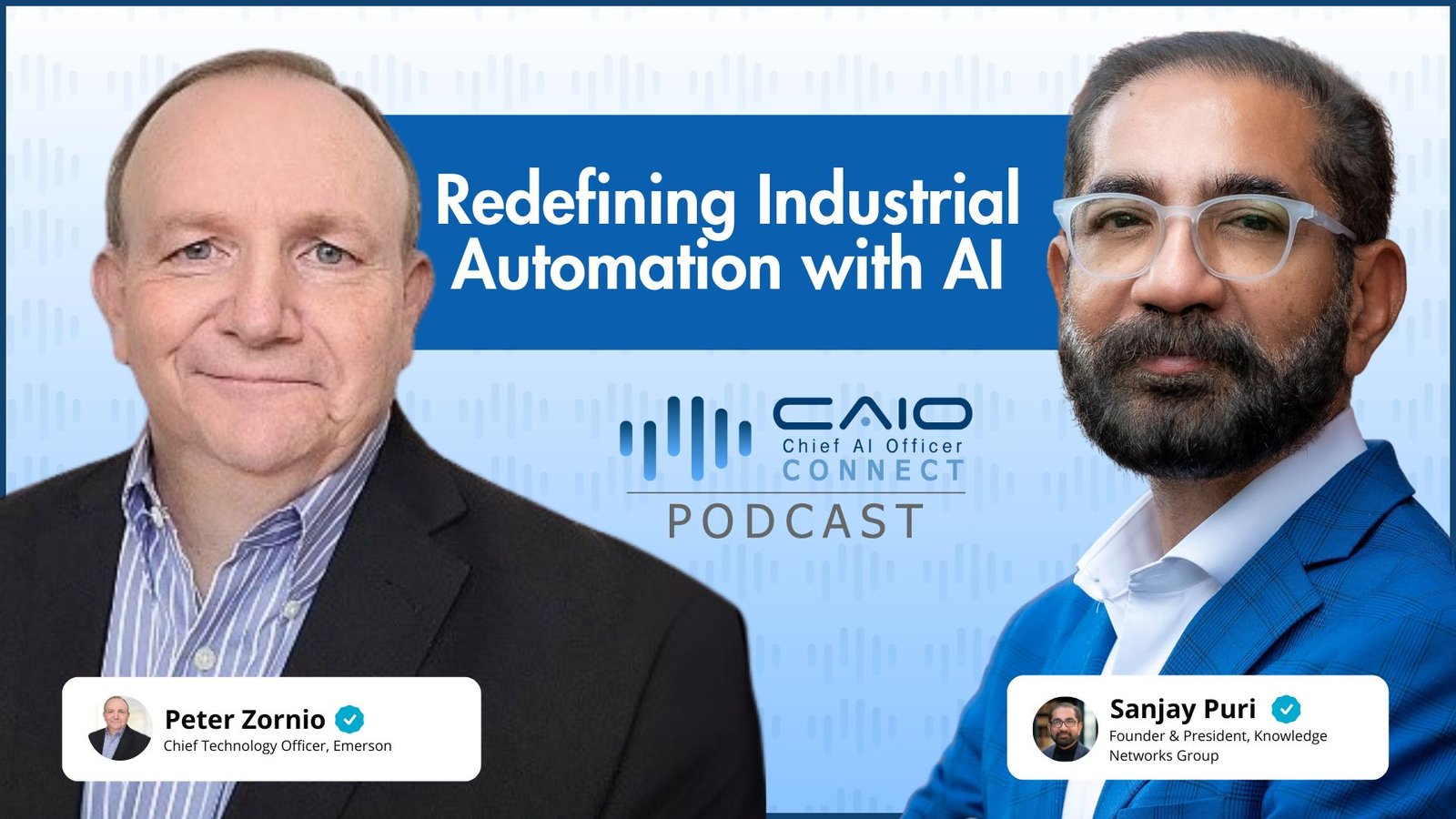Tools & Platforms
Emerson CTO Peter Zornio on boundless innovation

By Soumoshree Mukherjee
Editor’s note: This article is based on insights from a podcast series. The views expressed in the podcast reflect the speakers’ perspectives and do not necessarily represent those of this publication. Readers are encouraged to explore the full podcast for additional context.
In a recent episode of the “CAIO Podcast,” hosted by Sanjay Puri, Emerson’s Chief Technology Officer Peter Zornio shared his four-decade journey through chemical engineering, industrial automation, and the integration of artificial intelligence into manufacturing. With 19 years at Emerson and 21 years at Honeywell, Zornio has witnessed and shaped the evolution of automation from analog controls to AI-driven optimization.
Emerson, a 130-year-old technology and software company, has in recent years transformed into a focused automation leader, offering complete solutions “from sensors to optimization.”
“With automation, we’re pretty much applying computer science and automation and software technologies to the control of industrial chemical processes,” Zornio explained, recalling how digitization began in the 1970s and by the mid-1980s had matured into model-based process optimization.
“I always like to say in automation, we were AI before AI was cool,” he quipped, noting that manufacturing had long used numerical models and machine learning for tasks like advanced process control and predictive maintenance.
READ: Abdullah Althawad discusses Saudi Arabia’s vision for data and AI transformation (
Today, Emerson’s “Boundless Automation” vision centers on building architectures designed for AI from the ground up. The goal is to make industrial data from production metrics to sustainability figures easily accessible and integrated, enabling optimization, predictive maintenance, and improved safety. As Zornio notes, “There is no AI strategy in manufacturing without a data strategy.”
He pointed, “the single most tangible set of benefits… that have been delivered over the last couple of decades, all revolve around advanced process control and optimization,” while highlighting multimillion-dollar productivity gains, predictive analytics preventing costly equipment failures, and emerging generative AI tools supporting “digital twins” to guide plant operators in real time.
Future advancements aim to leverage large language models and generative AI to enhance digital twins and operator guidance systems, “…that will use a lot of the latest LLMs and generative technology will be on providing more of a comprehensive digital twin to provide operator guidance as operators are operating the facility.”
However, industrial AI comes with unique challenges. Manufacturers demand explainable models they can trust to make autonomous adjustments especially in high-risk environments. Data security is another priority, with many clients preferring edge deployments over cloud to maintain control of sensitive operational data.
“In our world, AI has always been about closing the loop and taking action on whatever was coming out of the AI,” Zornio said. Emerson’s approach often involves deploying AI at the edge to balance performance, security, and latency.
READ: Leading AI transformation at H&R Block: In conversation with Aditya Thadani (
Sustainability is another focus area. AI-driven optimization now includes energy efficiency and decarbonization as core performance variables, enabling clients to meet environmental goals without sacrificing output or reliability. Zornio also sees AI as a driver for IT-OT (Information Technology-Operational Technology) convergence, pushing manufacturing and enterprise systems closer together to unlock new efficiencies.
As head of Emerson Ventures, Zornio keeps an eye on applied AI startups, particularly in sensor innovation and automated data integration. He’s optimistic but pragmatic about new technologies: “Don’t get excited just about the technology. Make sure that you’re starting with what the business problem is and where the value is going to be.”
From venture investments in sensor innovations to AI-powered data integration startups, Emerson’s eyes are firmly on the future. Yet Zornio remains grounded in a philosophy of trust, security, and measurable value. As he puts it, “The value is going to be for companies like ourselves that take that technology and apply it to delivering results.”
This blend of history, innovation, and pragmatism is why, under Zornio’s leadership, Emerson continues to shape the evolution of intelligent industrial systems quietly proving that in automation, the AI revolution began long before the hype.
Tools & Platforms
Surge in Alibabas Volume Amid Tech Shifts and AI Investments

Nvidia dropped solidly by -3.32%, with the trading volume of 42.33B. UAE AI company G42 is seeking to diversify its chip supply beyond Nvidia, including negotiations with tech giants like Amazon AWS, Google, Meta, Microsoft, and xAI for its planned AI park. Google is reportedly leading in these discussions.
2. Tesla (Nasdaq: TSLA)
Tesla dropped solidly by -3.50%, with the trading volume of 27.32B. Tesla’s CEO Elon Musk states that 80% of Tesla’s value will depend on the Optimus robot. Despite challenges in Europe, including executive resistance and competition, Tesla lowered Model 3 prices in China, marking its long-range version’s debut with a price cut.
3. Alibaba Group Holding Limited (NYSE: BABA)
Alibaba Group Holding Limited surged by 12.90%, with the trading volume of 10.94B. Alibaba plans to invest over 380 billion yuan in the next three years to boost its computing power industry, impacting domestic AI infrastructure. Its Q1 FY 2026 financial report showed a 10% revenue growth and a 76% net profit increase, exceeding expectations.
4. Microsoft (Nasdaq: MSFT)
Microsoft dipped mildly by -0.58%, with the trading volume of 10.63B. UAE AI company G42 is diversifying chip supplies to reduce dependency on Nvidia, engaging with tech giants like Amazon AWS, Google, Meta, Microsoft, and Elon Musk’s xAI for a planned AI park, with Google’s negotiations being the most advanced.
5. Apple (Nasdaq: AAPL)
Apple dipped mildly by -0.18%, with the trading volume of 9.16B. Apple is expanding its retail footprint in India with a new store, Apple Hebbal, set to open in Bangalore on September 2. This follows the openings of Apple BKC in Mumbai and Apple Saket in Delhi. Apple also plans to remove physical SIM card slots in more countries for the iPhone 17 series.
6. Alphabet (Nasdaq: GOOGL)
Alphabet gained mildly by 0.60%, with the trading volume of 8.44B. UAE’s AI company G42 is seeking to diversify its chip suppliers to reduce reliance on Nvidia. They are negotiating with major tech companies including Amazon AWS, Google, Meta, Microsoft, and Elon Musk’s xAI, with Google likely to sign a computing power procurement deal soon.
7. Palantir Technologies (NYSE: PLTR)
Palantir Technologies dipped mildly by -0.89%, with the trading volume of 7.27B. South Korean retail investors showed significant interest in Palantir Technologies, with substantial net purchases over the past week.
8. Meta Platforms (Nasdaq: META)
Meta Platforms dipped mildly by -1.65%, with the trading volume of 6.70B. Meta and Scale AI’s partnership faced challenges as major investment leads to strained relations and data quality concerns. Additionally, Meta plans to release a smart glasses SDK, diverging from trends by opting for LCoS over Micro LED technology.
9. Broadcom (Nasdaq: AVGO)
Broadcom dropped solidly by -3.65%, with the trading volume of 6.42B. Broadcom (AVGO.US) is expected to report a 21% revenue increase to $15.82 billion for Q3, with EPS projected at $1.66. Oppenheimer reaffirmed its “outperform” rating, raising the target price to $325. The AI business could exceed $5 billion in revenue.
10. Marvell Technology (Nasdaq: MRVL)
Marvell Technology plunged by -18.60%, with the trading volume of 6.19B. Company XYZ announced plans for global expansion, focusing on emerging markets and sustainable initiatives. New partnerships aim to enhance technological capabilities, while leadership emphasizes innovation and growth potential.
Tools & Platforms
Americans Embrace AI Tech In Their Cars But Some Features Drive Them Crazy
A new JD Pwoer study reveals which AI features drivers actually love and which ones are still frustratingly confusing
31 minutes ago

- Owners are proving particularly receptive to smart climate control systems.
- Genesis took out top honors for innovation for the fifth consecutive year.
- There is also growing demand from buyers for in-car payment systems.
Artificial intelligence has been steadily weaving its way into everyday life, from the phones in our pockets to the services we rely on daily. The auto industry has been no exception, and AI-driven features are now shaping how people interact with their cars.
Α new study from J.D. Power has found that while some of these features are being well-received by consumers, there are many others that need work before they actually start adding to the ownership experience.
Read: JLR Is Now Using The AI Damage Scanners That Hertz Customers Hate
As part of an expansion of its annual U.S. Tech Experience Index (TXI) Study, J.D. Power looked at seven AI-based technologies that should, in theory, enhance the driving experience. Among them, one of the clear successes is smart climate control, which automatically manages heating, ventilation, and air conditioning to balance comfort and efficiency.
Smarter Comfort in Action
The study found that owners using these systems are now reporting 6.3 fewer problems per 100 vehicles (PP100) than before, a meaningful improvement. These systems also provide a much-needed workaround for the growing number of cars that have moved climate settings into touchscreen menus instead of physical buttons. J.D. Power’s broader studies back this up, noting that smart climate controls are now boosting both vehicle quality scores and customer satisfaction overall.
Other AI-based systems are also showing promise, such as smart ignition and driver preference modes. In-vehicle shopping and payment systems also drew attention, with 62 percent of owners expressing interest. So far, the most common uses are paying for fuel, tolls, parking, or EV charging, but past designs have struggled with clunky menus and limited apps.
According to the study, the next generation could succeed if automakers focus on simple, quick purchases tied directly to the driving experience.

Blind spot cameras stand out as one of the most appreciated technologies, with 93 percent of drivers saying they use them regularly and 74 percent wanting the feature in their next vehicle. Models equipped with blind spot cameras also tend to sell faster than those without, underlining just how valuable the technology has become.
Features That Miss the Mark
By comparison, several other AI features could be improved. For example, J.D. Power concluded that car wash modes becoming increasingly prevalent across the market have lots of room for improvement. These models automatically prepare a vehicle to go through a car wash, but it was found that this mode is often buried within the infotainment system, and 38 percent of owners say they need better instructions on how to use it.
Similar, recognition technologies remain a sticking point, posting the highest problem rates in the study. Biometric authentication alone averaged more than 29 issues per 100 vehicles, while touchless or hidden controls and direct driver monitoring each saw more than 19.
Which Brands Are The Best For Tech?
The study also compared automakers on their overall use of technology. Genesis once again led the pack, taking the top spot for the fifth year in a row, with Cadillac and Lincoln following behind.
The premium segment’s average score was lifted to 671 with Tesla and Rivian included, but both were excluded from the rankings since they did not meet the study’s award criteria. Even so, Tesla posted a standout score of 873 and Rivian followed with 730, according to J.D. Power.

In the mass-market category, Hyundai claimed the highest score for innovation, followed by Kia and, perhaps more surprisingly, Mitsubishi, which ranked ahead of GMC, MINI, and Toyota.
At the other end of the spectrum, Stellantis brands such as Jeep, Ram, and Chrysler landed at the bottom, while Jaguar held the lowest position among premium marques. And if you’re wondering about Tesla, while giving it a huge score at 873, JD Power said it


JD Power
Tools & Platforms
AI-powered cameras aim to make Gulf Shores’ roads safer

GULF SHORES, Ala. (WALA) – The City of Gulf Shores is using the power of Artificial Intelligence to track events and make the city safer. It’s the only city in the state and one of just 40 in the country to use this particular AI system to monitor intersection activity.
“So, it tells me that this is a near-miss where a car cut another car off,” said Gulf Shores City Engineer, Jenny Wolfschlag as she referenced her computer monitor. “The first car was going southeast, and the second car was going westbound. It left a dot where the accident would have happened if they would have been traveling at a little bit different speed and actually hit each other.”
Wolfschlag has a new, high-tech tool to help her department analyze problems with traffic patterns and make decisions on the best safety-related changes to make. Gulf Shores is the first city in Alabama to put the DERQ-AI platform to work on the street and Wolfschlag said it’s already proving its worth.
“The data that we’re getting out of that system is fantastic,” Wolfschlag said. “One thing that it does that’s really interesting, it produces hot spot maps, so we can pull up a heat map and see in particular, where pedestrians are crossing illegally.”
The integrated camera system does far more than monitor traffic flow in real time. It is also tied into the city’s Centrac’s software platform, allowing on the fly adjustments to signal timing based on the amount, and direction of traffic. It can even track pedestrian traffic, something Wolfschlag sees as a valuable feature.
“For example, if you have a group of one or two people crossing the street, it will set a set time. It might give them twenty seconds to cross the street, but if it recognizes a person with a mobility aid, it can automatically adjust that and maybe give them twenty-five seconds to cross the street,” Wolfschlag explained.
Those driving around or walking to the beach would never know Artificial Intelligence was at work making the trip quicker and safer. Those I pointed it out to were impressed and happy to learn of the city’s investment into this technology.
“AI is changing so we might as well adapt to certain situations, but I think it will be good,” Austin Nguyen of Fairhope said.
“I think it’s a great idea,” agreed Mo Rhazi of Baton Rouge. “I think it’s always great to collect data and improve the safety and make sure that you can avoid. Always, a proactive solution is always better than reactive.”
Right now, the only intersection covered by this new AI technology in at Hwy. 59 and E/W Beach Blvd., but that will soon change. The goal is to have an AI device at every intersection between there and Fort Morgan Road.
“Since this really integrates that pedestrian with the vehicle movement, we thought it would be a good place to start. We’re also going to put in in the light at our new high school that is getting ready to open in August of next year,” added Wolfschlag.
It costs the city around $40,000 per intersection to install the DERQ – AI platform. The hope is that they’ll be able to transition at least one intersection per year until the goal is reached.
Copyright 2025 WALA. All rights reserved.
-

 Business3 days ago
Business3 days agoThe Guardian view on Trump and the Fed: independence is no substitute for accountability | Editorial
-
Tools & Platforms3 weeks ago
Building Trust in Military AI Starts with Opening the Black Box – War on the Rocks
-

 Ethics & Policy1 month ago
Ethics & Policy1 month agoSDAIA Supports Saudi Arabia’s Leadership in Shaping Global AI Ethics, Policy, and Research – وكالة الأنباء السعودية
-

 Events & Conferences3 months ago
Events & Conferences3 months agoJourney to 1000 models: Scaling Instagram’s recommendation system
-

 Jobs & Careers2 months ago
Jobs & Careers2 months agoMumbai-based Perplexity Alternative Has 60k+ Users Without Funding
-

 Funding & Business2 months ago
Funding & Business2 months agoKayak and Expedia race to build AI travel agents that turn social posts into itineraries
-

 Education2 months ago
Education2 months agoVEX Robotics launches AI-powered classroom robotics system
-

 Podcasts & Talks2 months ago
Podcasts & Talks2 months agoHappy 4th of July! 🎆 Made with Veo 3 in Gemini
-

 Podcasts & Talks2 months ago
Podcasts & Talks2 months agoOpenAI 🤝 @teamganassi
-

 Mergers & Acquisitions2 months ago
Mergers & Acquisitions2 months agoDonald Trump suggests US government review subsidies to Elon Musk’s companies

















